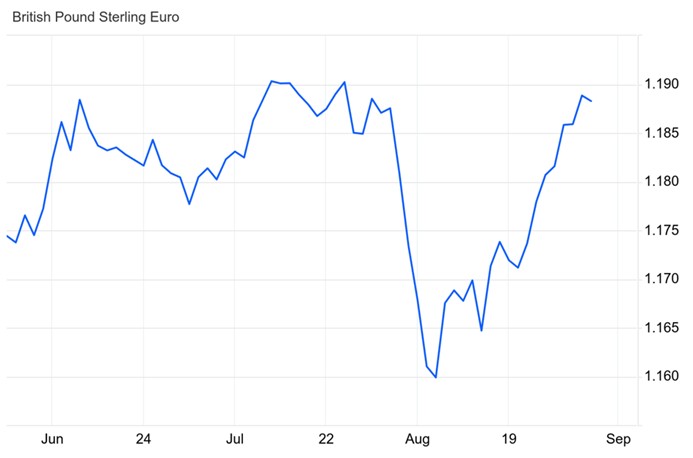GBP/EUR Exchange rate breaks through 1.19 in August
The pound euro exchange rate was subdued on 1 August despite the Bank of England (BoE) enacting a widely expected interest rate reduction – its first since 2020. The knife-edge decision, which saw central bank rate-setters vote 5-4 in favour of loosening policy, limited the UK currency’s losses.
Having been pressured by BoE headwinds in the wake of the cut, the pound firmed against the euro on 8 August, rising into the 1.16 mid-range. The publication of an upbeat US jobs report caused the single currency to soften due to its negative trading relationship with a strengthening dollar.
The pound euro rate teetered close to a one-week high, a fraction below 1.17, on 12 August following hawkish remarks from BoE official Catherine Mann, who cautioned against being “seduced” by lower domestic inflation amid underlying price pressures.
The pound edged above 1.17 on 13 August after UK unemployment numbers for June beat forecasts. British unemployment eased to 4.2%, falling from an almost three-year high of 4.4%, and printing below market expectations of 4.5%. Meanwhile, wage growth slowed less than expected.
The pound euro rate slumped into the 1.16 mid-range on 14 August following news of cooling UK inflation in July that served to ramp up BoE rate cut bets. The UK’s headline inflation print came in lower than expected, rising from a previous reading of 2% to 2.2%, missing forecasts of a slightly higher increase to 2.3%.
The pound recouped its losses on 15 August, rising back above 1.17, amid an upbeat UK GDP reading. The preliminary estimate for the second quarter came in at 0.6%, in line with market expectations, only marginally dipping from 0.7% in the first quarter – propelling the economy even further away from its shallow recession at the end of last year.
The pound continued to firm against the euro the following day after the UK’s retail sales data showed activity recovered in July.
The pound euro rate traded sideways, despite decelerating German producer prices and UK tax rise concerns, before strengthening to around 1.178 on 22 August as UK PMIs beat forecasts. The UK manufacturing sector expanded at its fastest pace in two years, with the index rising to 52.5, surpassing market forecasts of 52.1. Meanwhile, services activity increased from 52.5 to 53.3, above market projections of 52.8.
The pair broke through 1.18 the following day, hitting a 23-day high, buoyed by waning BoE rate cut expectations for September and tailwinds from the upbeat PMI print.
Having extended its gains amid factors like an anticipated European Central Bank (ECB) rate cut in September, the pound tested the 1.19 benchmark on 29 August following the release of German inflation data. News of cooler-than-forecast inflation in the Eurozone’s largest economy reinforced ECB rate cut speculation.
The pound euro rate edged above 1.19 the next day for the first time since the end of July after the Eurozone consumer prices print for August showed inflation in the bloc cooled to its lowest level in over three years – intensifying ECB rate cut speculation.
The pound euro exchange rate ended the month at 1.187.
GBPEUR: 3-Month Chart

Looking ahead
A second rate cut from the BoE in September seems unlikely, given ongoing UK wage growth and persistent inflation in the services sector.
Influential data from the UK economy in September: ILO Unemployment Rate (10 September), Average Earnings Excluding Bonus (10 September), Consumer Price Index (18 September), Retail Sales (20 September), S&P Global/CIPS Composite PMI (24 September), GDP (30 September).
Cooling inflation has removed one of the last remaining obstacles to an interest rate cut from the ECB in September – a move that could weigh on the euro.






